Istanbul Airport
Istanbul Airport (IATA: IST, ICAO: LTFM) (Turkish: İstanbul Havalimanı)[3] is the main international airport serving Istanbul, Turkey. It is located in the Arnavutköy district on the European side of the city.
Istanbul Airport İstanbul Havalimanı | |||||||||||||||||||||||||||
|---|---|---|---|---|---|---|---|---|---|---|---|---|---|---|---|---|---|---|---|---|---|---|---|---|---|---|---|
 | |||||||||||||||||||||||||||
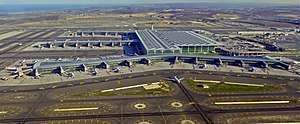 | |||||||||||||||||||||||||||
| Summary | |||||||||||||||||||||||||||
| Airport type | Public | ||||||||||||||||||||||||||
| Owner | General Directorate of State Airports (DHMİ) | ||||||||||||||||||||||||||
| Operator | IGA (Istanbul Grand Airport) Havalimanı İşletmesi A.Ş. | ||||||||||||||||||||||||||
| Serves | Istanbul, Turkey | ||||||||||||||||||||||||||
| Location | Arnavutköy, Istanbul | ||||||||||||||||||||||||||
| Opened | 29 October 2018[1] | ||||||||||||||||||||||||||
| Hub for | |||||||||||||||||||||||||||
| Time zone | TRT (UTC+03:00) | ||||||||||||||||||||||||||
| Elevation AMSL | 99 m / 325 ft | ||||||||||||||||||||||||||
| Coordinates | 41°15′44″N 28°43′40″E | ||||||||||||||||||||||||||
| Website | www | ||||||||||||||||||||||||||
| Map | |||||||||||||||||||||||||||
 Istanbul Airport Location of airport  Istanbul Airport Istanbul Airport (Turkey)  Istanbul Airport Istanbul Airport (Europe) 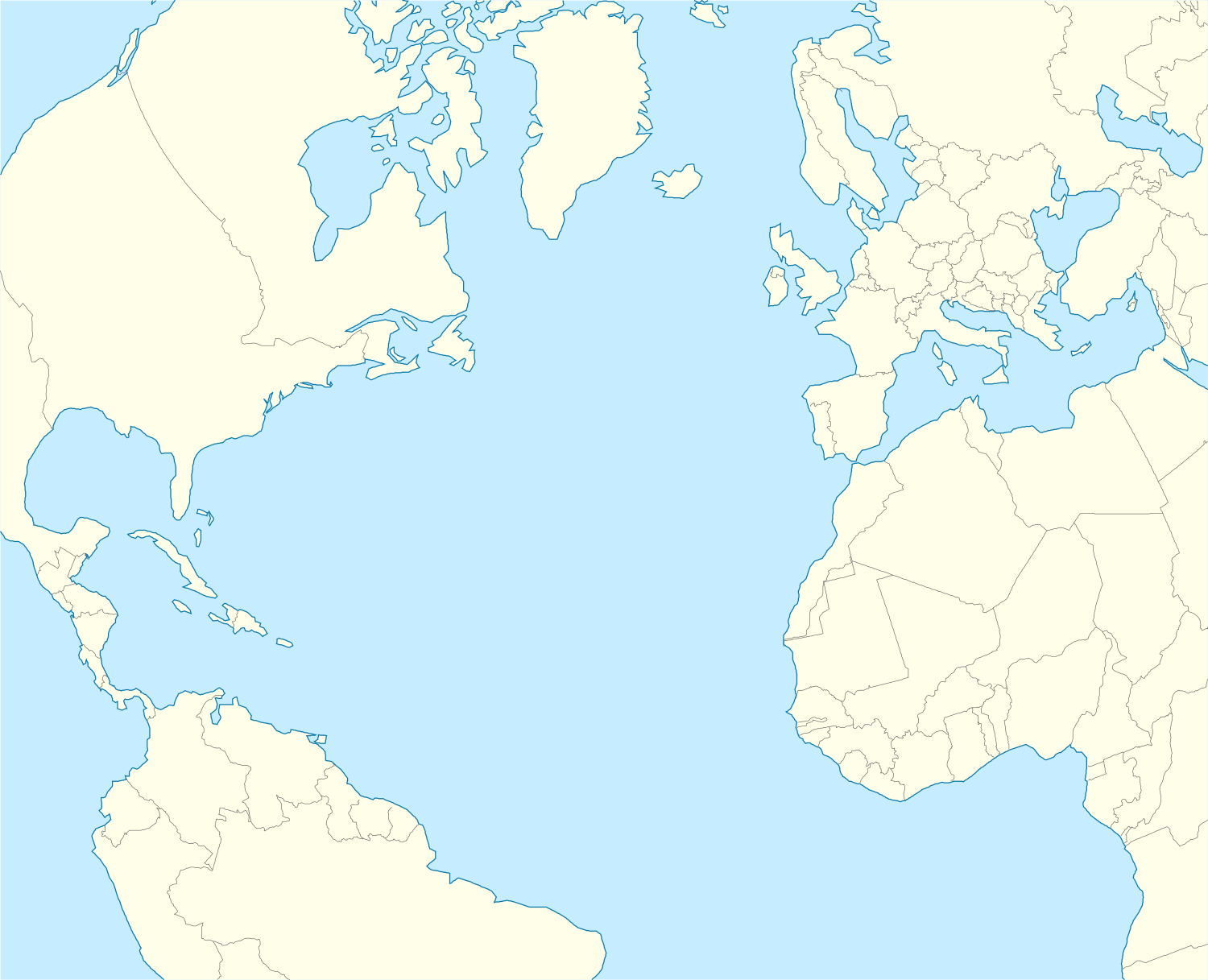 Istanbul Airport Istanbul Airport (North Atlantic) | |||||||||||||||||||||||||||
| Runways | |||||||||||||||||||||||||||
| |||||||||||||||||||||||||||
| Statistics (2019) | |||||||||||||||||||||||||||
| |||||||||||||||||||||||||||
Source: (Turkish AIP at Eurocontrol) Turkey[2] | |||||||||||||||||||||||||||
All scheduled commercial passenger flights were transferred from Istanbul Atatürk Airport to Istanbul Airport on April 6, 2019, following the closure of Istanbul Atatürk Airport for scheduled passenger flights.[4] The IATA airport code IST was also transferred to the new airport.[5] Once all phases are completed by the mid-2020s, the airport will be able to accommodate 200 million passengers a year.[6]
History
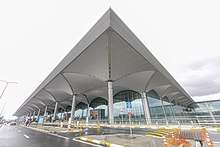
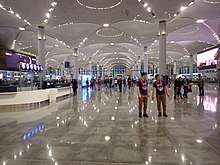
.jpg)
Background
Due to a lack of space to construct an additional runway at Istanbul Atatürk Airport, airport growth being restricted due to the growth of the city, the Turkish Airport Authority not allowing additional cargo or charter flights to the airport, and worsening air traffic congestion, it was decided to construct a new airport to serve Istanbul. Furthermore, due to a lack of slot capacity and parking spaces, some of Turkish Airlines' aircraft were based in Sabiha Gökçen Airport which itself is already at maximum terminal capacity of 25 million passengers, and handled 28 million passengers in 2015 after posting traffic growth rates averaging over 20% a year since 2013.
Atatürk Airport was one of the busiest airports in Europe. Since 2013, it has ranked among the five busiest airports in Europe by passenger traffic. In 2017, the two Istanbul airports handled over 100 million passengers.[7] In terms of area airports, the six London-area airports serve more than 150 million passengers a year, while the three Paris-area airports serve around 100 million passengers a year.
Location
It was decided to construct the new airport at the intersection of roads to Arnavutköy, Göktürk, and Çatalca, north of central Istanbul and between the Black Sea coast towns of Yeniköy, Tayakadın and Akpınar. The area is a 7,659-hectare (18,930-acre) region near Lake Terkos. Some 6,172 hectares (15,250 acres) of this area was state-owned forest. The distance between Istanbul Airport and Atatürk Airport is approximately 35 km (22 mi). The area encompassed old open-pit coal mines, which were later filled with soil.[8]
According to the Environmental Impact Assessment (ÇED) report published in April 2013, there were a total of 2,513,341 trees in the area and 657,950 of them would need to be cut indispensably, while 1,855,391 trees would be moved to new places. However, the Ministry of Forest and Water Management claimed the exact number of trees cut and moved would only be revealed after construction was complete.[8]
Construction
.png)
The tender for construction and operation of the facility until mid-2020s was held on May 3, 2013.[9] The project is made up of four construction stages. If all stages are completed, the airport will reach a capacity of 200 million passengers, which would have made it the biggest in the world at the time of planning. The first stage of construction was planned to finish within 42 months of the handover of the land. The total project cost is expected to be approximately €7 billion, excluding financing costs. The construction and operation consortium has been guaranteed 342 million passengers in 12 years by the government.
The design team was led by London-based Grimshaw[10] and also included the Norway-based Nordic Office of Architecture and London studio Haptic.
At the bidding session on May 3, 2013, only four out of fifteen Turkish and two foreign companies that were qualified as bidders showed up. The Turkish joint venture consortium of Cengiz-Kolin-Limak-Mapa-Kalyon won the tender, and were obliged to pay the government €26.142 billion including value-added tax for a 25-year lease starting from 2018. The completion date of the construction's first stage was officially set for 2018 – 42 months after the finalization of the tender's approval.[8]
The groundbreaking ceremony took place on 7 June 2014,[11] though construction only started in May 2015 after the land was officially handed over.[12]
The inauguration of the airport took place on the planned date of 29 October 2018. It was reported that the first test landing at the airport would take place on February 26, 2018; however, the first landing took place on 20 June 2018.[13] Testing of navigational and electronic systems with DHMİ aircraft had begun on 15 May 2018.[14]
The control tower is in the shape of the Turkish national flower, the tulip.[15]
Project stages
The construction of the airport is taking place in several stages, expanding the airport and its facilities over time.[9][16][17][18]
The first stage consists of the main terminal, with an annual passenger capacity of 90 million and an area of 1,440,000 m2 (15,500,000 sq ft) – making it the world's largest airport terminal building under a single roof,[19] despite Dubai International Airport Terminal 3 having a larger floor area at 1,713,000 m2 (18,440,000 sq ft) due to tunnels connecting its two concourses. There will also be two pairs of parallel runways connected to eight parallel taxiways to the west of the main terminal, approximately 4,000,000 m2 (43,000,000 sq ft) of apron space, and an indoor car-park with a capacity of 12,000 vehicles. In addition, the airport will feature three technical blocks for repairs, maintenance, and fueling, as well as an air traffic control tower, eight ramp control towers, and hangars for cargo and general aviation aircraft.[20] Several other services are also to be in operation, including hospitals, frequent-flyer and VIP lounges, prayer rooms, convention centers, and hotels; some of these are expected to form part of the Istanbul Airport City project.[21]
The second stage will add a third independent runway to the east of the main terminal, as well as a fourth remote runway with an east–west heading and additional taxiways and apron areas. The third stage is planned to add a second passenger terminal with a capacity of 60 million annual passengers and an estimated area of around 960,000 m2 (10,300,000 sq ft), as well as an additional runway and a new support facilities area. The final and fourth stage of expansion will, along with adding another runway, allow for the construction of satellite terminals with a combined capacity of 50 million passengers and area of up to 800,000 m2 (8,600,000 sq ft) if needed.[20]
Once fully completed by 2025, the airport will have six sets of runways (eight in total), 16 taxiways, and a total annual passenger capacity of 150 million passengers.[19][22] If fully expanded to a capacity of 200 million, the airport will exhibit four terminal buildings with interconnecting rail access that combine for a total indoor area of 3,200,000 m2 (34,000,000 sq ft). The airport will also have a 6,500,000 m2 (70,000,000 sq ft) apron with a parking capacity of 500 aircraft, VIP lounges, cargo and general aviation facilities, a state palace, and indoor and outdoor parking that can accommodate up to 70,000 cars. A medical center, aircraft rescue and firefighting stations, hotels, convention centers, power plants, and wastewater treatment facilities will also be built.
Controversies
The Turkish Chamber of Environmental Engineers (ÇMO) took the project tender to court on grounds that the project violated the existing legislation for the preparation of the Environmental Impact Assessment (ÇED) report.[8] In February 2014, an Istanbul administrative court ordered construction of the airport to be suspended.[23] However, the groundbreaking ceremony took place a few months later, on 7 June 2014.[11]
A report published in Turkish newspaper Cumhuriyet in February 2018 claimed that more than 400 workers had been killed during the construction of the airport, with accidents killing three to four workers every week, and families of the killed workers being paid to remain silent about the incidents.[24][25] Turkish daily Evrensel also alleged that fatal accidents continued to occur.[25] This prompted opposition MP Veli Ağbaba to submit a written questionnaire to the Turkish parliament on 13 February 2018. In response, the Turkish Ministry of Labour and Social Security claimed that there were only 27 fatalities during the construction of the airport.[26] In October 2019, UK publications Construction News and Architects' Journal published a joint investigation into fatalities at the airport - nicknamed by workers "the cemetery" as so many have died.[27] By this point, the official death toll was 55, but unofficial estimates suggested the figure could "be higher than 400". Four architects worked on the airport's design, three of them UK-based: Grimshaw Architects, Scott Brownrigg and Haptic Architects.[27]
Mass worker protests broke out on 14 September 2018 after a bus carrying workers crashed, injuring 17. Complaints by workers included poor living conditions in "vermin-infested dormitories", issues in transportation that had left them stranded under the rain or on site during holidays, and long delays in payments, among others.[28][29] Police and gendarmerie forces were called in and workers eventually returned to work under alleged threats of arrest or further withholding of wages.[28]
On 19 December 2018, part of the airport site was flooded after heavy rain.[30]
In January 2020, the MP Meral Danış Bestaş demanded an explanation for why the new translation service of 36 languages at Istanbul Airport did not include Kurdish, a language spoken by a large minority within Turkey.[31]
Operations
The opening ceremony took place on 29 October 2018, scheduled so as to coincide with the 95th anniversary of the proclamation of the Turkish Republic.[32] The airport had been unofficially known as 'Istanbul New Airport' during construction - the new official name of 'Istanbul Airport' was announced at the opening ceremony. The first flight from the airport was Turkish Airlines flight TK2124 to the Turkish capital Ankara on 31 October 2018.[33] On 1 November 2018, five daily flights began to arrive and depart from the airport: from Ankara, Antalya, Baku, North Nicosia, and İzmir,[34] followed by Adana and Trabzon starting in December.
Before the full transfer, all flights were operated exclusively by Turkish Airlines. Regularly scheduled flights to all of the new airport's destinations continued to depart from Atatürk and Sabiha Gökçen airports alongside these trial flights. It was originally planned that on 31 December 2018, all equipment from Atatürk Airport would be transferred to the new airport via the O-7 Motorway.[35][36] As of 17 January 2019, the transfer phase was set to start 1 March 2019.[37] However, on 25 February, the transfer phase was moved a fourth time to 5 April 2019.[38]
The full transfer of all scheduled commercial passenger flights from Istanbul Atatürk Airport to the new Istanbul Airport took place on 6 April 2019 between 02:00 and 14:00. Hundreds of trucks carried more than 10,000 pieces of equipment, each weighing about 44 tons were moved to the new airport over 41 hours.[39] Istanbul Atatürk Airport's IATA code IST was also transferred to the new airport.
Facilities
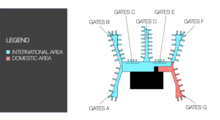
The airport currently has one terminal in service for domestic and international flights and four runways that are currently in operation. The two 17/35 runways are both 4,100 metres (13,451 feet) long, while the 16/34 runways are both 3,750 metres (12,303 feet) long. Runways 17L/35R and 16R/34L are 60 metres (197 feet) wide, while 17R/35L and 16L/34R are 45 metres (148 feet) wide. All runway surfaces are asphalt.[40]
Concourses
The airport features a total of five concourses lettered A, B, D, F, and G with a total of 143 passenger boarding bridges. Concourse G, which is located in the southeast, is reserved solely for domestic flights. Three passenger boarding bridges of Concourse F which is directly to the north of Concourse G has also been allocated for domestic flights. Concourses A, B, D, and F will be used for international flights. The C and E concourses connect directly to the main terminal and are therefore not independent concourses.[41]
Security
3,500 security personnel and a total of 1,850 police, including 750 immigration officers, are expected to provide the airport's security.[42] The site's perimeter will be protected using ground radar, fixed CCTV cameras every 60 meters, pan–tilt–zoom cameras every 360 meters, thermal cameras and fiber optic sensors every 720 meters. The active terminal building uses up to 9,000 CCTV cameras.[43]
Airlines and destinations
Passenger
Cargo
As of July 2020, there are no regularly scheduled cargo operations at the airport, as they currently still remain at Istanbul Atatürk Airport while extensive cargo handling facilities are to be built at the new airport.
Statistics
Below is the passenger data and development for Istanbul Airport for the years 2018–2020:[49]
| Year | Domestic passengers |
Passenger % change |
International passenger |
Passenger % change |
Total passenger |
Passenger % change |
World rank international |
World rank total |
|---|---|---|---|---|---|---|---|---|
| 20181 | 65,124 | 30,206 | 95,330 | |||||
| 2019 | 12,720,826 | 39,857,182 | 52,578,008 | |||||
| 2020 (Jan) | 1,263,808 | 4,012,452 | 5,276,260 |
^1 : 2018 statistics correspond to the last 3 months of 2018 since the opening of the airport.
Ground transport
Although currently the airport is only serviced from the city by affordable private Havaist and public İETT buses,[50] it will eventually be linked by two lines of the Istanbul Metro. The new M11 line starting from Gayrettepe station is scheduled to open in August 2021. Another from Halkalı on the Marmaray rail line is expected to be completed in 2022.[51]
Mainline railway will connect the airport to Halkalı, and via outer city bypass running over the Yavuz Sultan Selim Bridge across the Bosporus and connecting with the Asian rail network at Gebze.
References
- "Istanbul Airport, 'world's new hub,' officially opened". www.aa.com.tr.
- "General Directorate Of State Airports Authority". Retrieved 9 February 2020.
- "Yeni havalimanının adı belli oldu (İstanbul Havalimanı tabelaları asıldı)". NTV.
- "Last flight leaves Ataturk as Istanbul switches airports". Reuters.
- "Turkish Airlines relocates to new Istanbul Airport". ATWOnline. 5 April 2019.
- "Turkish Airlines is switching to a new Istanbul airport – all in 45 hours". Guardian. 6 April 2019. Retrieved 13 April 2019.
The opening date has been pushed back three times, but authorities insist that the main terminal building and two runways will be fully operational by Sunday, in what critics say it is a rushed and dangerous attempt to stay on schedule.
- "Turkish Airport Traffic Statistics". DHMI Turkey. Retrieved 18 March 2016.
- "Consortium wins Istanbul airport tender for 22.1 billion euros". Hürriyet Daily News. 3 May 2013. Retrieved 3 May 2013.
- "Dünyanın en büyük havalimanı İstanbul'a yapılıyor". Star. 24 January 2013. Retrieved 24 January 2013.
- Architects, Grimshaw. "Istanbul New Airport". grimshaw.global. Retrieved 2 October 2018.
- Grundsteinlegung für Mega-Flughafen in Istanbul. welt.de, 7. Juni 2014; retrieved, 8 June 2014
- "Construction of new Istanbul airport officially starts under shadow of challenges, questions". 18 July 2015. Archived from the original on 2 August 2015. Retrieved 21 July 2015.
- - "Istanbul Grand Airport to open in October 2018" (German) 6 October 2017
- "3. Havalimanı'nın yüzde 90'ı tamamlandı". trthaber.com (in Turkish). 27 May 2018. Archived from the original on 1 July 2018. Retrieved 1 October 2018.
- Suri, Charu (25 October 2018). "This New Airport Is Larger Than Manhattan". Architectural Digest. Retrieved 15 June 2019.
- "Istanbul's third airport 71 pct completed". Daily Sabah. Retrieved 10 November 2017.
- "İGA - About the Construction". igairport.com. Archived from the original on 28 March 2018. Retrieved 27 March 2018.
- "İGA - Aşamalar". www.igairport.com. Archived from the original on 30 April 2018. Retrieved 27 March 2018.
- "Construction - İGA". igairport.com. Archived from the original on 1 April 2019. Retrieved 6 April 2019.
- "Phases - İGA". igairport.com. Archived from the original on 1 April 2019. Retrieved 6 April 2019.
- "Istanbul Airport City - İGA". igairport.com. Retrieved 6 April 2019.
- Ay, Hasan. "Havalimanı değil zafer anıtı". sabah.com.tr. Sabah. Retrieved 8 June 2014.
- "İstanbul court orders suspension of 3rd airport's construction". Today's Zaman. 10 February 2014. Archived from the original on 26 February 2014. Retrieved 8 June 2014.
- Güsten, Susanne (25 February 2018). "Staunen und Sterben auf dem neuen Mega-Flughafen in Istanbul" [Amazement and dying at the new mega-airport in Istanbul]. Augsburger Allgemeine (in German). Retrieved 26 February 2018.
- Seibert, Thomas (25 February 2018). "Mega airport project in Turkey's Istanbul rocked by deaths of dozens of workers". The Arab Weekly. Retrieved 31 October 2018.
- Boyacıoğlu, Hacer (14 February 2018). "Turkish government says 27 workers killed in Istanbul's third airport construction". Hürriyet. Retrieved 26 February 2018.
- Garner-Purkis, Zac; Hurst, Will (10 October 2019). "Investigation: the human cost of building the world's biggest airport". Architects' Journal. Retrieved 10 October 2019.
- "Workers forced to build new airport under gendarmerie supervision in Istanbul". Ahval. 17 September 2018. Archived from the original on 15 October 2018. Retrieved 15 October 2018.
- Öztürk, Fundanur (20 September 2018). "3. Havalimanı eylemleri: İşçiler ne talep ediyor, ana firma İGA taleplere ne diyor?". BBC News Türkçe (in Turkish). Archived from the original on 15 October 2018. Retrieved 15 October 2018.
- "Istanbul's new airport site floods after heavy rain". 19 December 2018. Retrieved 20 December 2018.
- "Kurdish absent from Istanbul Airport's instant translation service". Ahval. Retrieved 6 March 2020.
- "'Istanbul Airport' inaugurated as Erdoğan says Atatürk Airport will remain in downsized form". Hürriyet Daily News. 29 October 2018. Retrieved 29 October 2018.
- "First flight departs from Istanbul's new airport". The Washington Post. Retrieved 2 November 2018.
- "Yeni Havalimanı'nda THY'nin ilk uçuş fiyatları belli oldu". Habertürk.
- "Kokpit.aero'nun dediği çıktı: İstanbul Yeni Havalimanı için taşınma tarihi açıklandı". www.kokpit.aero (in Turkish). 5 October 2018. Retrieved 6 October 2018.
- "New Istanbul airport to only open fully at end of year: paper". Reuters. 13 October 2018. Retrieved 15 October 2018.
- "TRANSFER PROGRAMME FOR ISTANBUL AIRPORT (LTFM)" (PDF). Eurocontrol NOP. 17 January 2019.
- "TRANSFER PROGRAMME FOR ISTANBUL AIRPORT (LTFM)" (PDF). Eurocontrol NOP. 25 February 2019.
- Insider, Alexandra Ma, Business. "Turkey's national carrier moved all its flights from Istanbul's old airport to its shiny replacement in a single, stressful, 41-hour 'big bang'". Business Insider Deutschland (in German). Retrieved 9 April 2019.
- "LTFM Chart". 4 October 2018. Archived from the original on 6 November 2018.
- "Istanbul Airport Map".
- "29 Ekim'de ilk etabı açılacak". Habertürk (in Turkish). 3 November 2018. Archived from the original on 6 November 2018. Retrieved 6 November 2018.
- "İlk kez İstanbul Havalimanı'nda kullanılacak". NTV. 3 November 2018. Archived from the original on 6 November 2018. Retrieved 6 November 2018.
- https://www.routesonline.com/news/29/breaking-news/289028/ana-to-launch-tokyo-haneda-istanbul-route-shifts-three-us-routes-from-narita-to-haneda/
- Liu, Jim. "SkyUp Airlines adds Kyiv – Istanbul service from late-Sep 2020". Routesonline. Retrieved 7 August 2020.
- https://www.routesonline.com/news/38/airlineroute/291843/turkish-airlines-delays-osaka-service-resumption-to-march-2021/
- https://www.routesonline.com/news/38/airlineroute/289347/turkish-airlines-schedules-vancouver-launch-in-june-2020/
- Liu, Jim. "Turkish Airlines moves Newark / Vancouver addition to Oct 2020". Routesonline. Retrieved 14 August 2020.
- "İstatistikler" (PDF). DHMI. December 2019. Retrieved 8 January 2020.
- "Public Transport - İGA". igairport.com. Retrieved 6 April 2019.
- "Istanbul airport metro tracklaying begins". 21 January 2020.
External links
![]()